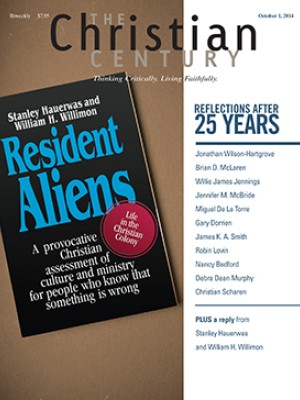Sunday, October 5, 2014: Isaiah 5:1-7; Matthew 21:33-46
Economists warn us with increasing urgency about the sharply widening income gaps that mark the American economy, about the disappearance of the middle class and the end of the social contract. The usual effects of income inequality are in evidence: stock market growth without similar gains in jobs or job security, financial speculation and bubbles, growing political corruption. Such things typically lead to class alienation, to wagons circling around ideological and religious legitimations, and eventually to violence.
These are the ways of human empires, whether ancient or modern. But how do you help people see what is happening around them and to them—to connect the dots, nurture hope, and encourage alternative practices? Narratives that help people see their world more clearly are crucial tools in shaping anti-imperial vision and resilience.
Read our latest issue or browse back issues.
Jesus’ parable of the so-called wicked tenant farmers is a textbook illustration—a parody, even—of the economic and political dynamics of empire. But the parable has usually been interpreted as a religious allegory culminating in God’s judgment on Israel for killing God’s son and the subsequent replacement of Israel by more suitable tenants, that is, the (gentile) church. We should be wary of the self-serving and anti-Semitic aspects of this Christian interpretation. Allegorical readings tend to obscure, if not supplant, the dynamics of the story itself.
Like Mark, Matthew begins this parable with a scenario that recalls the parable of the vineyard in Isaiah 5. In Isaiah the primary issue is that the vineyard, a stock symbol for Israel itself, produces thorns (an outpouring of bloodshed from exploitation) instead of grapes (justice and right social relationships). All of the beloved’s efforts to situate, prepare, and secure the vineyard come to naught, which leads the beloved to remove the vineyard’s protections and allow it to be trampled, wasted, and abandoned. The whole vineyard (Israel) suffers destruction for its failure to produce fruit.
In Matthew and Mark’s parables, the problem is not that the vineyard fails to produce fruit, but that its produce is withheld from the legal owner. We tend to blame the tenant farmers wholly for the crisis the parable describes. But in Jesus’ day there was widespread dispossession of smallholders from their family lands. So perhaps the tenants’ behavior reflects their conviction that their best hope is to repossess the land by whatever means they can. At a minimum, the tenants’ actions seem to represent an act of desperation, a reflection of their vulnerability in a subsistence economy.
Jesus uses the parable not only to describe violent economic realities and the politics of retribution but also to invite the leaders of Israel into issuing their own judgment. The judgment they pronounce makes clear how they align themselves with the characters in the story. The chief priests and elders were themselves the wealthy landowners in first-century Judah, the beneficiaries of imperial economics and politics who used their power in the temple system to deprive subsistence farmers of their land. So they identify with the landowner, not the tenants. In Matthew’s version, Jesus asks them what they would do if they found themselves in the circumstances the parable describes, and they answer without hesitation: “He will put those wretches to a miserable death, and lease the vineyard to other tenants who will give him the produce at the harvest time.”
The parable is thus not just a lens on the economic realities of the day but also a mirror for the chief priests. Jesus’ citation of Psalm 118 in reply suggests a reversal of expectations: the rejected stone becomes the cornerstone. By the end of the story it is clear to the Judean elites that Jesus means for them to identify not with the landowner but with the desperate, usurping, and violent tenants who keep the produce for themselves. He accepts the sentence they would hand down to their tenant farmers as the judgment they will now themselves receive.
When the parable is read as an allegory of God’s judgment against Israel, an implicit assumption is made that God would think and act like the Jewish elites. This interpretation presumes that, in the end, God is more like the Jewish elites than like the agent of healing, redemption, and mercy that Jesus has been describing during his ministry. Are the Jewish elites right about who God is?
It’s more consistent with Matthew’s larger frame to conclude instead that by declaring what they would do, the Jewish elites pronounce their own judgment, one that is congruent not only with their own practices but with their perception of who God is. This does not mean, however, that their self-understanding defines who God is or circumscribes God’s capacity to act in forgiveness or mercy toward others.
Jesus uses the parable to entrap the Jewish leaders into pronouncing their own judgment, and it has entrapped subsequent generations of interpreters as well. Modern Western readers have a strong tendency to identify the male authority figure in parables with God, even in stories where that figure behaves like a wealthy elite or a despot. In doing so, we usually affirm an understanding of God as an authoritarian judge. And perhaps, then, that is how God will act toward us.
But maybe Matthew uses this parable to invite us to ask ourselves who God is: the God of the Jewish leaders in the story, or the God of Jesus Christ?





